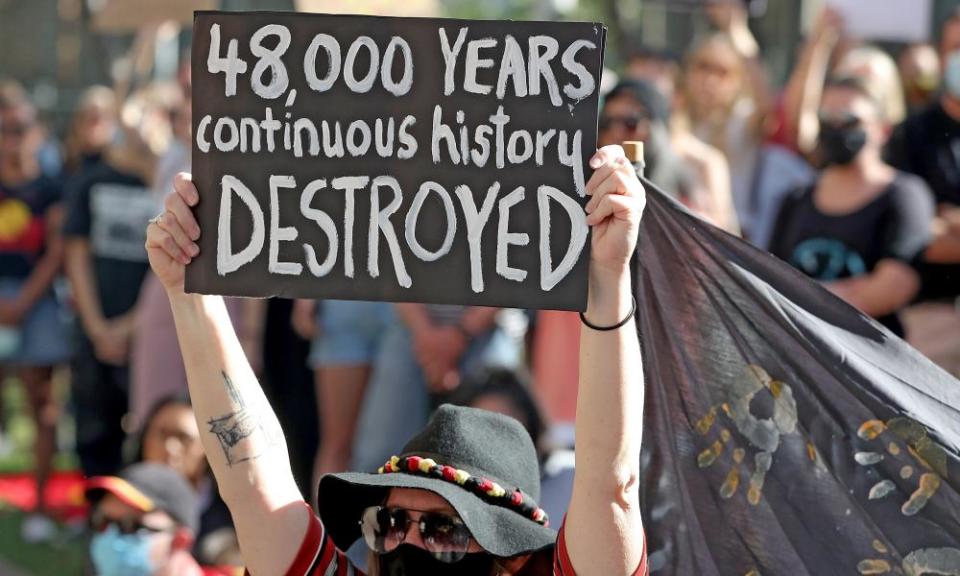Culture warriors obsessed with statues ignore Rio Tinto’s vandalism of Indigenous heritage

As the professional offence takers at News Corp and elsewhere bring themselves to repeated rage-gasms over the vandalism of Captain Cook statues and the removal of Chris Lilley in blackface from streaming platforms, they ignore, more or less entirely, the incalculably more important obliteration of cultural heritage taking place in the Australian desert.
A few weeks ago Rio Tinto dynamited the Juukan rock shelters, destroying, in a few minutes, a site of human occupation dating back more than 40,000 years. Gone with the Wind remains available online (Google it!) despite HBO Max’s decision to (temporarily) drop it. But the caves – described as “staggering” by scientists who worked on them – have been ruined for all time.
In a hundred years, when no one remembers whether or not Jonah from Tonga could be downloaded from the ABC, the destruction of the rock shelters will remain an unhealed wound.
Furthermore, as the archaeologist Dr Kathryn Przywolnik says, their ruination wasn’t anomalous but typical of mining giants’ treatment of Indigenous heritage. She lists 36 significant sites excavated in Eastern Guruma country over the last decade.
Twenty-five of them, she says, have since been wiped out.
Indeed, before the outcry against Rio, BHP had been scheduled to demolish 40 sites treasured by the Banjima people in the Pilbara.
The ongoing disrespect shown to Indigenous heritage reflects precisely the racism highlighted by the rallies taking place all over the world. Had Rio Tinto blown up Saint Paul’s cathedral its executives would be in jail. The insouciance with which the company (entirely legally) demolished caves cherished by the Puutu Kunti Kurrama landowners illustrates what does and doesn’t matter to some of the most powerful men in Australia.
Locations such as the Juukan sites possess a special significance to the local people who have maintained a connection with them over thousands of years. But, like the ruins of Rome, they’re treasures for all of humanity, enabling us to discover profound truths about our species stretching back into deep time.
If an Italian company demolished the Colosseum, we’d all be outraged, correctly judging the desecration a crime against the human spirit. Yet, with a few honourable exceptions, the commentators most obsessed by monuments have shown no concern at all about Rio Tinto’s vandalism.
In fact, for all its teary apologies, Rio itself still believes it did nothing wrong. It’s got a business to run and the caves got in the way. Resources equal money, and money trumps culture.
An older generation of conservatives lauded tradition, custom and family as ends in themselves. Robert Menzies could, perhaps, have mounted a credible Arnoldian defence of high culture but, for years now, the Australian right’s been fundamentally committed to a free market in which value only registers as monetary price.
As a result, when a culture warrior taps out highfalutin prose about heritage and history, one thinks of a chimpanzee sporting a top hat and monocle.
If, for instance, you wanted to study the literary classics that Menzies venerated, where, precisely, would you go? The universities no longer offer old-fashioned liberal arts courses, not because of political correctness gone mad but because higher education now functions primarily as a commercial enterprise, assiduously separating overseas students from their savings.
Similarly, as Gladys Berejiklian threatens new penalties for those who menace statues, New South Wales entirely lacks any stand-alone Indigenous heritage legislation. Last year, for instance, light rail construction destroyed an Indigenous site in Sydney from which more than 2,400 artefacts had been unearthed.
Again, that’s not surprising, given the willingness of successive governments to cosy up to rapacious developers, assiduously tearing down history of any kind. The architect Philip Thalis has noted how privatisation and the dilution of heritage codes were transforming Sydney into “a throwaway city of junk buildings”.
It’s not just NSW, either. A few years ago one expert estimated that Australia lost 800 historically significant houses each and every week as developers turned them into apartments.
That’s what makes the statue debate so utterly cynical.
If you care about such things, you’ll know that the relentless mediocrity of most Australian public statuary isn’t a coincidence. Milan Kundera describes how kitsch in eastern Europe (a region that knew something about monuments) functioned to give all answers in advance and to preclude any questions. On precisely that basis, avant garde or experimental sculptors rarely got a gig when Australian politicians commissioned statues of explorers. The authorities didn’t want interesting art; they wanted didactic national statements carved out of stone and they chose accordingly.
If our pundits genuinely worried about public culture, they’d be lobbying to support sculptors and other artists impoverished by the coronavirus so that we might end up with street art that’s better (both politically and aesthetically) in the future.
But, of course, they don’t and they won’t. They care as little about western art as they do about Indigenous heritage – unless and until it’s useful to score political points.
The real threat to culture in Australia doesn’t come from a few protesters daubing paint on Captain Cook. It comes from an economic system in which human values possess no monetary worth, as the fate of the Juukan caves shows.

 Yahoo Sports
Yahoo Sports 